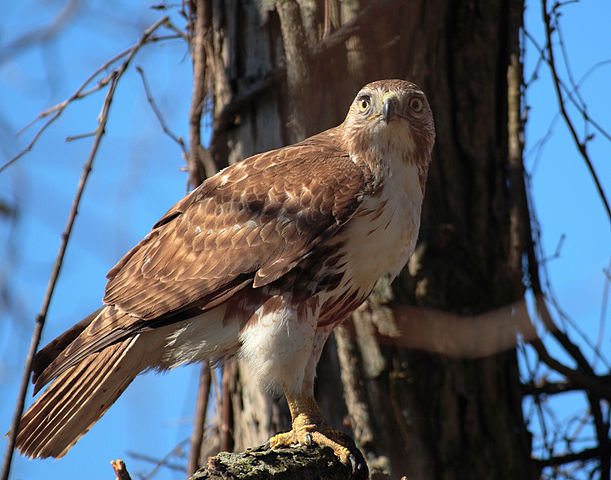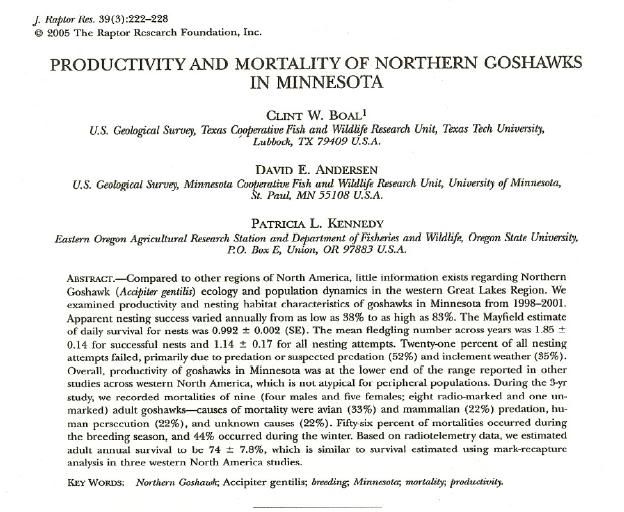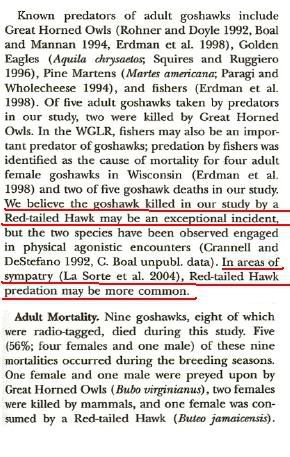Post by Eaglehawk on Jul 28, 2019 11:42:43 GMT
Northern Goshawk - Accipiter gentilis
The Northern Goshawk, Accipiter gentilis, is a medium-large bird of prey in the family Accipitridae, which also includes other diurnal raptors, such as eagles, buzzards and harriers. As a species in the Accipiter genus, the goshawk is often considered a "true hawk". It is a widespread species that inhabits the temperate parts of the northern hemisphere. It is the only species in the Accipiter genus found in both Eurasia and North America. The Northern Goshawk, like all accipiters, exhibits sexual dimorphism, where females are significantly larger than males. Males, being the smaller sex by around 10–25%, are 46–57 cm (18–22 in) long and have a 89–105 cm (35–41 in) wingspan. The female is much larger, 58–69 cm (23–27 in) long with a 108–127 cm (43–50 in) wingspan.[5][6] Males average around 780 g (1.7 lb), with a range of 500 to 1,200 g (1.1 to 2.6 lb).[5] The female can be more than twice as heavy, averaging 1,220 g (2.7 lb) with a range of 820 to 2,200 g (1.8 to 4.9 lb). This species hunts birds and mammals in a variety of woodland habitats, often utilizing a combination of speed and obstructing cover to ambush birds and mammals. Goshawks are often seen flying along adjoining habitat types, such as the edge of a forest and meadow; flying low and fast hoping to surprise unsuspecting prey. They are usually opportunistic predators, as are most birds of prey. The most important prey species are small mammals and birds found in forest habitats, in North America, this is compromised largely by grouse, American Crow, snowshoe hare, and red squirrel.

Red-tailed Hawk - Buteo jamaicensis
The Red-tailed Hawk (Buteo jamaicensis) is a bird of prey, one of three species colloquially known in the United States as the "chickenhawk," though it rarely preys on standard sized chickens. It breeds throughout most of North America, from western Alaska and northern Canada to as far south as Panama and the West Indies, and is one of the most common buteos in North America. Red-tailed Hawks can acclimate to all the biomes within its range. There are fourteen recognized subspecies, which vary in appearance and range. It is one of the largest members of the genus Buteo in North America. A male Red-Tailed Hawk may weigh from 690 to 1300 g (1.5 to 2.9 lb) and measure 45–56 cm (18 to 22 in), while a female can weigh between 900 and 2000 g (2 and 4.4 lb) and measure 48 to 65 cm (19 to 26 in) long; wingspan is about 114 to 133 cm (45 to 52 in). As is the case with many raptors the Red-tailed Hawk displays sexual dimorphism in size, as females are up to 25% larger than males. The Red-tailed Hawk is carnivorous, and an opportunistic feeder. Its diet is mainly small mammals, but it also includes birds and reptiles. Prey varies with regional and seasonal availability, but usually centers on rodents, comprising up to 85% of a hawk's diet. Most commonly reported prey types include mice, voles, chipmunks, ground squirrels, tree squirrels and woodchucks.

The Northern Goshawk, Accipiter gentilis, is a medium-large bird of prey in the family Accipitridae, which also includes other diurnal raptors, such as eagles, buzzards and harriers. As a species in the Accipiter genus, the goshawk is often considered a "true hawk". It is a widespread species that inhabits the temperate parts of the northern hemisphere. It is the only species in the Accipiter genus found in both Eurasia and North America. The Northern Goshawk, like all accipiters, exhibits sexual dimorphism, where females are significantly larger than males. Males, being the smaller sex by around 10–25%, are 46–57 cm (18–22 in) long and have a 89–105 cm (35–41 in) wingspan. The female is much larger, 58–69 cm (23–27 in) long with a 108–127 cm (43–50 in) wingspan.[5][6] Males average around 780 g (1.7 lb), with a range of 500 to 1,200 g (1.1 to 2.6 lb).[5] The female can be more than twice as heavy, averaging 1,220 g (2.7 lb) with a range of 820 to 2,200 g (1.8 to 4.9 lb). This species hunts birds and mammals in a variety of woodland habitats, often utilizing a combination of speed and obstructing cover to ambush birds and mammals. Goshawks are often seen flying along adjoining habitat types, such as the edge of a forest and meadow; flying low and fast hoping to surprise unsuspecting prey. They are usually opportunistic predators, as are most birds of prey. The most important prey species are small mammals and birds found in forest habitats, in North America, this is compromised largely by grouse, American Crow, snowshoe hare, and red squirrel.

Red-tailed Hawk - Buteo jamaicensis
The Red-tailed Hawk (Buteo jamaicensis) is a bird of prey, one of three species colloquially known in the United States as the "chickenhawk," though it rarely preys on standard sized chickens. It breeds throughout most of North America, from western Alaska and northern Canada to as far south as Panama and the West Indies, and is one of the most common buteos in North America. Red-tailed Hawks can acclimate to all the biomes within its range. There are fourteen recognized subspecies, which vary in appearance and range. It is one of the largest members of the genus Buteo in North America. A male Red-Tailed Hawk may weigh from 690 to 1300 g (1.5 to 2.9 lb) and measure 45–56 cm (18 to 22 in), while a female can weigh between 900 and 2000 g (2 and 4.4 lb) and measure 48 to 65 cm (19 to 26 in) long; wingspan is about 114 to 133 cm (45 to 52 in). As is the case with many raptors the Red-tailed Hawk displays sexual dimorphism in size, as females are up to 25% larger than males. The Red-tailed Hawk is carnivorous, and an opportunistic feeder. Its diet is mainly small mammals, but it also includes birds and reptiles. Prey varies with regional and seasonal availability, but usually centers on rodents, comprising up to 85% of a hawk's diet. Most commonly reported prey types include mice, voles, chipmunks, ground squirrels, tree squirrels and woodchucks.






